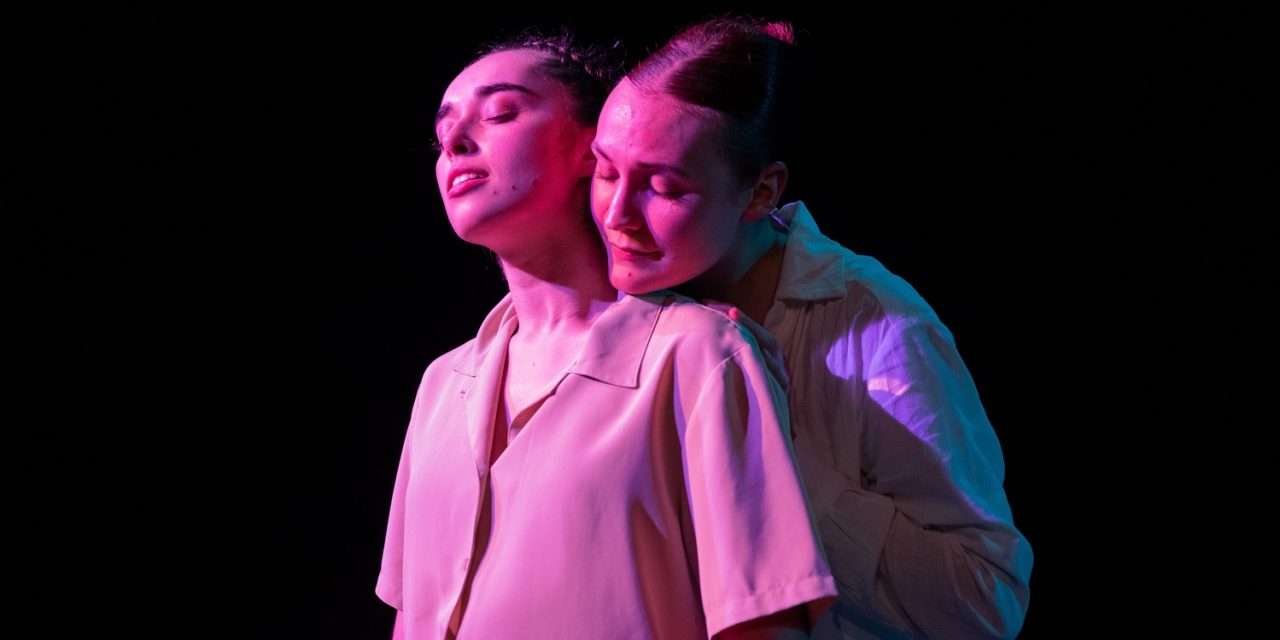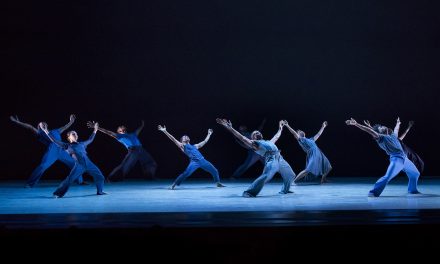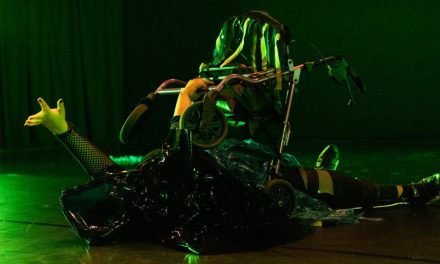Hannah Millar, Artistic Director and Founder of Imprints Dance Company, showcased her newest work Let Us Bleed, Then Heal at Stomping Ground LA this past Sunday. The 90 min performance took Millar, plus dancers and collaborators, almost two full years to conceive, rehearse, and bring to life. The story-driven work “[illustrated] the healing journey of Millar since the death of her Mom in 2014” and its emotional start to the timeline of events that unfolded was a grounding moment for anyone in the audience who has experienced grief.

Halie Donabedian, Bailey Holladay, Julia Gonzalez , Jordyn Maxfield, and Lexi Amundarain in Hannah Millar’s “Let Us Bleed, The Heal” – Photo by Tucker Maxfield
In the opening scene, we saw Bailey Holladay, portraying Millar’s mom, cradling her daughter Hannah, portrayed by Halie Donabedian, shrouded in a thick red fabric. As they began a series of movements from upstage left to downstage right, we saw Hannah take her first steps, we saw Hannah go to her first dance, and we saw Hannah graduate. On and on the small series of critical life moments went until we arrived at the end, when Millar’s mother assumingly passed on. We heard audio by Hannah Millar, as her voice read past journal entries about the loss, the discomfort, the hurt, and the growth she’s been through since her mother’s departure. The intimacy of the journal entries was accompanied by ASL interpreter’s Jill Nolen, Lark Detweiler, Julia Gonzalez, Jordyn Maxfield, and Alexis Amundarain as the words were signed by a single interpreter interchanging with one another downstage left in front of the audience. With so much context, both emotionally and physically thus far in the performance, the ASL was a needed mystery and riddle that the audience could focus on. It was nice to imagine what sign language meant for Millar, and why it was rooted in her work and life. The signing left room for the audience to insert their own feelings about ASL and the community it represents.

Imprints Dance Company – Halie Donabedian and Jordyn Maxfield in Hannah Millar’s “Let Us Bleed, Then Heal” – Photo by Maya Gorman
Beyond the character of Hannah and Hannah’s mom, we are introduced to the morphs as the piece progresses. The morph’s represented “the behind the scenes of what we feel happens in life but cannot see” which was well represented by the costume designer, Mary Leopo, who shrouded the morphs in black pants, black cloaks, and black mesh hoods covering the whole head and face. Represented by Julia Gonzalez, Jordyn Maxfield, Alexis Amundarain, and Lexi Maxfield, the morphs would bring props on and off stage, manipulate Hannah and her mother’s movements, as well as guide and direct characters in and out of life situations. At first, the morphs felt more like a distraction as they brought mirrors, couches, vacant picture frames, and other unnecessary props to the mainstage; however, as the performance progressed, I saw the power of the choreography. Each morph held a critical role in the lifting and sharing of weight onstage, completing complicated partnering patterns, and unusual silhouettes.

Imprints Dance Company – Halie Donabedian, Lexi Amundarain, Julia Gonzalez in Hannah Millar’s “Let Us Bleed, Then Heal” – Photo by Maya Gorman
The last act of the show, offered a reprieve from the heaviness of grief patterns through tough romantic relationships, 9-5 work in America’s corporate system, and of course the death of a mother. Each character entered the stage in light pastels and white colors, with swift swinging arms and airy legs as dancers floated from one side of the stage to the other. While the ending felt a tad predictable, you could feel that a huge weight had been lifted and a brighter future of acceptance was embodied with the characters, especially Hannah.

Imprints Dance Company – Julia Gonzalez and Bailey Holladay in Hannah Millar’s “Let Us Bleed, The Heal – Photo by Tucker Maxfield
While Let Us Bleed, Then Heal, was neither dance nor theater, I felt that it left no room for myself as an audience member to interpret my own relationship with losing a loved one. Unfortunately, there was so much imagery and audio explanation about what the dance was about, that it did not allow the movement, or how I felt about the movement, to stand on its own. Millar’s contact choreography and partnership was lost in clarifying the “what”, when the movement was beautifully grounded as an explanation unto itself. With such a potent and personal topic as grief, I so badly wanted the movement to influence my own memories and experiences with sadness and loss. However, I cannot deny that Millar’s emotional bravery to tackle the theme was successful in parts. The audience was often in tears, as sniffles could be heard throughout each scene. In one particular moment we saw a duet between Hannah and her mother at the end remembering the joy and the laughter they once shared in life. Without the props and the morphs influencing direction, it was the simplification of two souls dancing, appreciating, and listening to one another. Let Us Bleed, Then Heal accomplished its narrative to let it all out on the floor and heal the broken pieces, and while that’s never easy, it’s always worth it.
To learn more about Hannah Millar and Imprints Dance Company, please visit their website.
Written by Grace Courvoisier for LA Dance Chronicle.
Featured image: Imprints Dance Company – Halie Donabedian and Bailey Holladay in Hannah Millar’s Let Us Bleed, Then Heal – Photo Maya Gorman







